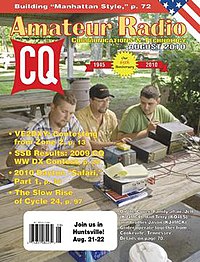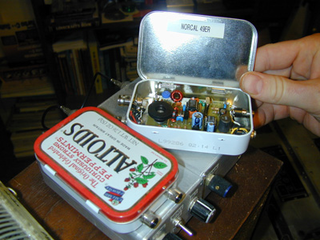
In amateur radio, QRP operation refers to transmitting at reduced power while attempting to maximize one's effective range. QRP operation is a specialized pursuit within the hobby that was first popularized in the early 1920s. QRP operators limit their transmitted RF output power to 5 W or less regardless of mode.

Radioteletype (RTTY) is a telecommunications system consisting originally of two or more electromechanical teleprinters in different locations connected by radio rather than a wired link. Radioteletype evolved from earlier landline teleprinter operations that began in the mid-1800s. The US Navy Department successfully tested printing telegraphy between an airplane and ground radio station in 1922. Later that year, the Radio Corporation of America successfully tested printing telegraphy via their Chatham, Massachusetts, radio station to the R.M.S. Majestic. Commercial RTTY systems were in active service between San Francisco and Honolulu as early as April 1932 and between San Francisco and New York City by 1934. The US military used radioteletype in the 1930s and expanded this usage during World War II. From the 1980s, teleprinters were replaced by personal computers (PCs) running software to emulate teleprinters.

The R-S-T system is used by amateur radio operators, shortwave listeners, and other radio hobbyists to exchange information about the quality of a radio signal being received. The code is a three digit number, with one digit each for conveying an assessment of the signal's readability, strength, and tone. The code was developed in 1934 by Amateur radio operator Arthur W. Braaten, W2BSR, and was similar to that codified in the ITU Radio Regulations, Cairo, 1938.
The American Radio Relay League (ARRL) is the largest membership association of amateur radio enthusiasts in the United States. ARRL is a non-profit organization, and was co-founded on April 6, 1914, by Hiram Percy Maxim and Clarence D. Tuska of Hartford, Connecticut. The ARRL represents the interests of amateur radio operators before federal regulatory bodies, provides technical advice and assistance to amateur radio enthusiasts, supports a number of educational programs and sponsors emergency communications service throughout the country. The ARRL has approximately 161,000 members. In addition to members in the US, the organization claims over 7,000 members in other countries. The ARRL publishes many books and a monthly membership journal called QST.
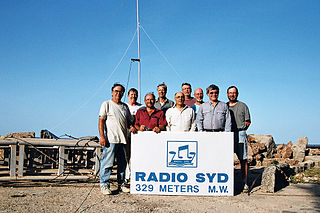
A DX-pedition is an expedition to what is considered an exotic place by amateur radio operators and DX listeners, typically because of its remoteness, access restrictions, or simply because there are very few radio amateurs active from that place. This could be an island, a country, or even a particular spot on a geographical grid. DX is a telegraphic shorthand for "distance" or "distant".
The Maidenhead Locator System is a geocode system used by amateur radio operators to succinctly describe their geographic coordinates, which replaced the deprecated QRA locator, which was limited to European contacts. Its purpose is to be concise, accurate, and robust in the face of interference and other adverse transmission conditions. The Maidenhead Locator System can describe locations anywhere in the world.

Field Day is an annual amateur radio contest, widely sponsored by IARU regions and member organizations, encouraging emergency communications preparedness among amateur radio operators. In the United States, it is typically the largest single emergency preparedness exercise in the country, with over 30,000 operators participating each year. Field Day is always the fourth full weekend of June, beginning at 18:00 UTC Saturday and running through 20:59 UTC Sunday.
CQ is a station code used by wireless operators derived from long established telegraphic practice on undersea cables and landlines, particularly used by those communicating in Morse code,, but also by voice operators, to make a general call. Transmitting the letters CQ on a particular radio frequency means that the transmission is a broadcast or "General Call" to anyone listening, and when the operator sends "K" or says "Go Ahead" it is an invitation for any licensed radio station listening on that frequency to respond. Its use on radio matched the existing use on Morse landline telegraphy and dates from the earliest wireless stations. It was widely used in point-to-point diplomatic and press services, maritime, aviation, and police services until those services eliminated Morse radiotelegraphy. It is still widely used in amateur radio which still has active use of Morse radiotelegraphy.
DXing, taken from DX, the telegraphic shorthand for "distance" or "distant", is the hobby of receiving and identifying distant radio or television signals, or making two-way radio contact with distant stations in amateur radio, citizens band radio or other two-way radio communications. Many DXers also attempt to obtain written verifications of reception or contact, sometimes referred to as "QSLs" or "veries".

Contesting is a competitive activity pursued by amateur radio operators. In a contest, an amateur radio station, which may be operated by an individual or a team, seeks to contact as many other amateur radio stations as possible in a given period of time and exchange information. Rules for each competition define the amateur radio bands, the mode of communication that may be used, and the kind of information that must be exchanged. The contacts made during the contest contribute to a score by which stations are ranked. Contest sponsors publish the results in magazines and on web sites.
Amateur radio frequency allocation is done by national telecommunication authorities. Globally, the International Telecommunication Union (ITU) oversees how much radio spectrum is set aside for amateur radio transmissions. Individual amateur stations are free to use any frequency within authorized frequency ranges; authorized bands may vary by the class of the station license.

An amateur radio station is a radio station designed to provide radiocommunications in the amateur radio service for an amateur radio operator. Radio amateurs build and operate several types of amateur radio stations, including fixed ground stations, mobile stations, space stations, and temporary field stations. A slang term often used for an amateur station's location is the shack, named after the small enclosures added to the upperworks of naval ships to hold early radio equipment and batteries.
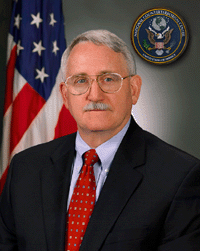
John Scott Redd is a retired vice admiral of the United States Navy, and afterward the first Senate-confirmed Director of the National Counterterrorism Center, serving from 2005 until 2007. According to David Martin at the CBS Evening News, "Scott Redd may be the most important person you've never heard of." J.J. Green at Federal News Radio referred to Redd as "the man that I often call "E.F. Hutton". He is also the past President of the Naval Academy Class of 1966 and has served on the advisory boards of several non-profit organizations. An avid amateur radio operator, Redd has won twelve world championships and nine national championships.
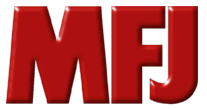
MFJ Enterprises, founded in 1972 by Martin F. Jue, is a manufacturer of a broad range of products for the amateur radio market. They specialize in station accessories, such as antenna tuners and antenna switching equipment. MFJ now manufactures more amateur radio products than any other company in the world.

Vintage amateur radio is a subset of amateur radio hobby where enthusiasts collect, restore, preserve, build, and operate amateur radio equipment from bygone years, such as those using vacuum tube technology. Popular modes of operation include speaking over amplitude modulation (AM), and communicating using Morse code through continuous wave (CW) radiotelegraphy. Some enthusiasts have interest in owning, restoring and operating vintage military and commercial radio equipment such as those from 1940s to 1960s. Some undertake to construct their own gear, known in ham slang as homebrewing, using vintage parts and designs. A number of amateur radio clubs and organizations sponsor contests, events, and swap meets that cater to this specialized aspect of the hobby.
Homebrew is an amateur radio slang term for home-built, noncommercial radio equipment. Design and construction of equipment from first principles is valued by amateur radio hobbyists, known as "hams", for educational value, and to allow experimentation and development of techniques or levels of performance not readily available as commercial products. Some items can be home-brewed at similar or lower cost than purchased equivalents.

Worldradio was a monthly amateur radio enthusiast magazine published in Sacramento, CA, United States from July 1971 to January 2009. The magazine was published in English and drew its subscription base primarily from the United States and Canada, although it had subscribers around the world. The staff of the magazine had an Amateur Radio club that was assigned the call sign WR6WR. This magazine is unrelated to a magazine called "World-Radio" published in the United Kingdom before World War II.
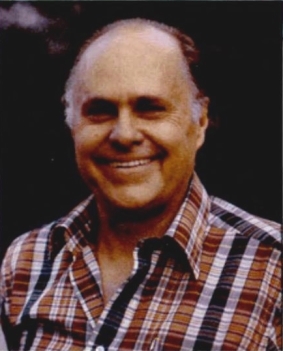
Wayne Sanger Green II was an American publisher, writer, and consultant. Green was editor of CQ magazine before he went on to found 73, 80 Micro, Byte, CD Review, Cold Fusion, Kilobaud Microcomputing, RUN, InCider, and Pico, as well as publishing books and running Instant Software.
Ham Radio (HR) was a monthly amateur radio enthusiast magazine published in the United States from November 1967 to June 1990.
